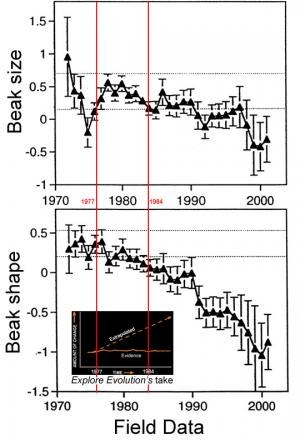Natural selection is one of the major mechanisms of evolution, but where most evolution textbooks discuss several such mechanisms, often devoting separate chapters to each, Explore Evolution ignores nearly all of them, devoting a chapter and a half to misrepresenting natural selection. The chapter devoted to this concept inaccurately describes natural selection, mischaracterizes several widely-known examples of natural selection at work, misconstruing howthe significance of those examples.
Students need to understand natural selection, and there are many inquiry-based techniques for teaching about it. Explore Evolution fails to offer any new additions to this literature. Worse yet, it neglects to even draw on that literature to help students deepen their understanding of this basic aspect of evolutionary biology.
p. 95: "changes in the sub-population take place as genetic information is lost to that population"
Ongoing research by geneticists and evolutionary biologists shows that evolutionary processes (including natural selection) do increase information, including through the evolution of new genes, and of genes that are better able to operate under novel conditions. Explore Evolution fails to confront this ongoing research, preferring to criticize decades-old experiments.
 Field data vs. Explore Evolution: An illustration of the evolution of finch beaks from Explore Evolution shows no relationship with actual data from the field. The former restricts its period of analysis to exclude periods of intense change, adding a line of "extrapolation" with no relationship to anything predicted by working scientists. Explore Evolution uses these inaccuracies to argue for a fallacious extrapolation: limits on the variation possible through natural selection.
Field data vs. Explore Evolution: An illustration of the evolution of finch beaks from Explore Evolution shows no relationship with actual data from the field. The former restricts its period of analysis to exclude periods of intense change, adding a line of "extrapolation" with no relationship to anything predicted by working scientists. Explore Evolution uses these inaccuracies to argue for a fallacious extrapolation: limits on the variation possible through natural selection. p. 94: "not only does the experiment [on peppered moths] not show what the story says it's supposed to, the experiment itself is highly questionable"
While Explore Evolution was being written, a researcher re-ran Kettlewell's classic experiment on peppered moths, correcting various criticisms offered of the original. The new research confirmed the original findings, and those findings affirm the importance of natural selection as an evolutionary mechanism.
p. 90: "definite, discoverable limits on what artificial [and therefore natural] selection can do"
Shortly before decrying extrapolation from short periods to long-term trends, Explore Evolution claims that limits on what animal breeders can accomplish over a century or two demonstrate that evolution could not produce the diversity of life we see over life's 4 billion year history. In fact, intensive selective breeding over a few hundred years has produced a range of sizes and morphologies among domestic dogs that exceeds the diversity of all other members of the family Carnivora. Whatever limits evolution reaches after intense selection, they are much smaller than what the diversity of life requires us to explain.
p. 87: "Is it possible that something like [artificial selection] occurs in nature only without any intelligence to guide it?"
Explore Evolution plays a slight of hand here, treating "intelligence" interchangeably with the practices of animal breeders, when the difference between artificial and natural selection lies not in the application of intellect, but the application of selective pressures other than those which would occur naturally. Natural selection will tend to be messier than artificial selection, zigging and zagging to match changing environmental conditions, but the practical aspects of each are identical. Explore Evolution wrongly treats artificial selection as an analogy for natural selection, when natural selection is just a more general process.
Major Flaws:
Natural and Artificial Selection: The nature of natural selection is obscured, confusing natural selection's use in evolutionary explanations, the relationship between natural selection and artificial selection, and the way in which evolution from generation to generation produces new genes and new anatomical structures.
Experiments: It is true that many textbooks describe classic experiments on the evolution of beak size in Gal pagos finches and peppered moths in England, they also discuss many other examples. Rather than further supplementing textbooks with new knowledge, Explore Evolution devotes itself to factually misleading accounts of those classic experiments, confusing students rather than deepening their understanding.
Extrapolation: Explore Evolution criticizes scientists for extrapolating from evolutionary changes over short timespans to long-term processes like speciation. Instead, the book encourages students to extrapolate from apparent limits to artificial selection to the existence of absolute limits to evolution. While the book's extrapolation is unjustified, the scientific study of evolution is not rooted in extrapolation but in detailed experimentation, mathematical modeling, and experimental hypothesis testing.
